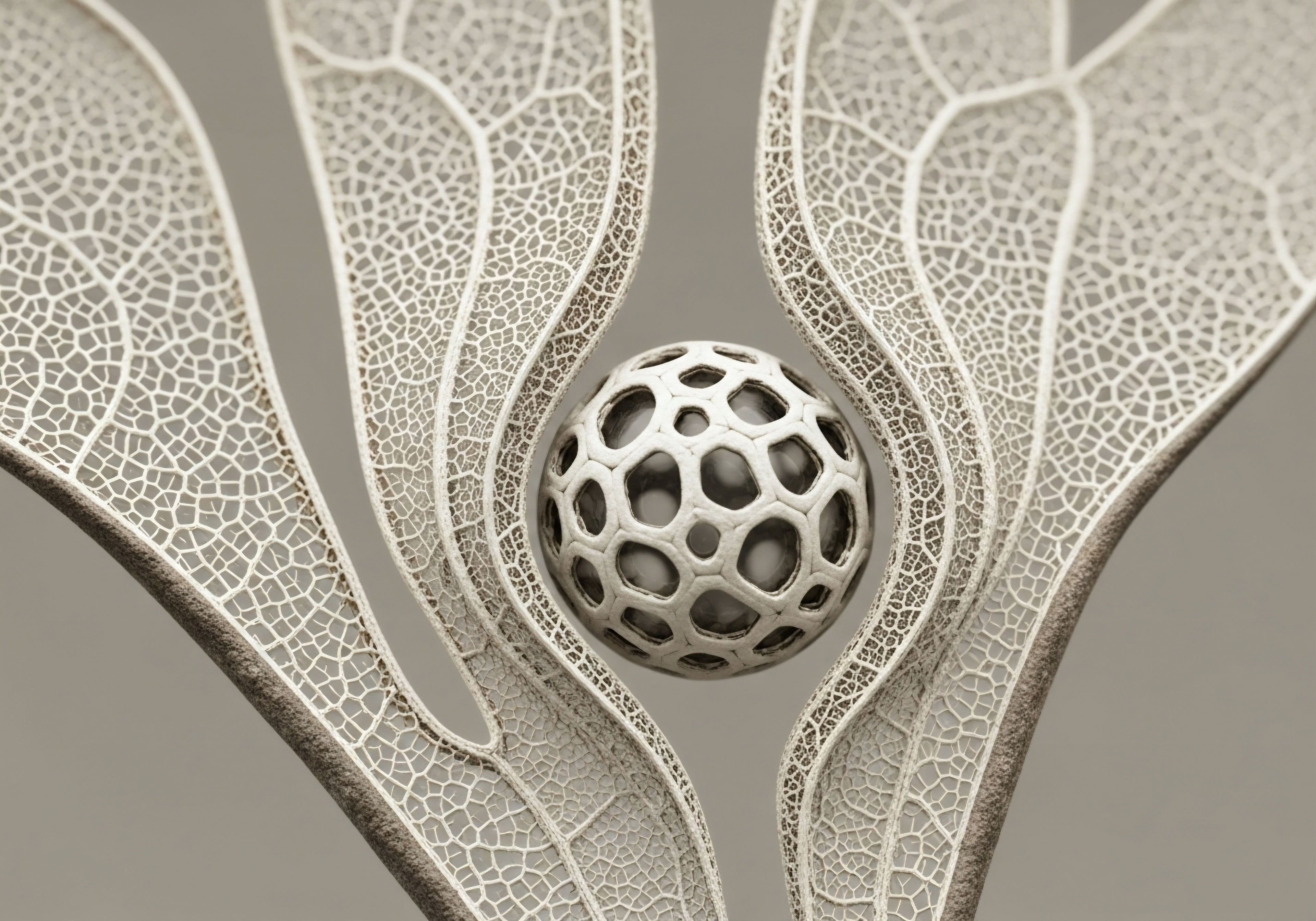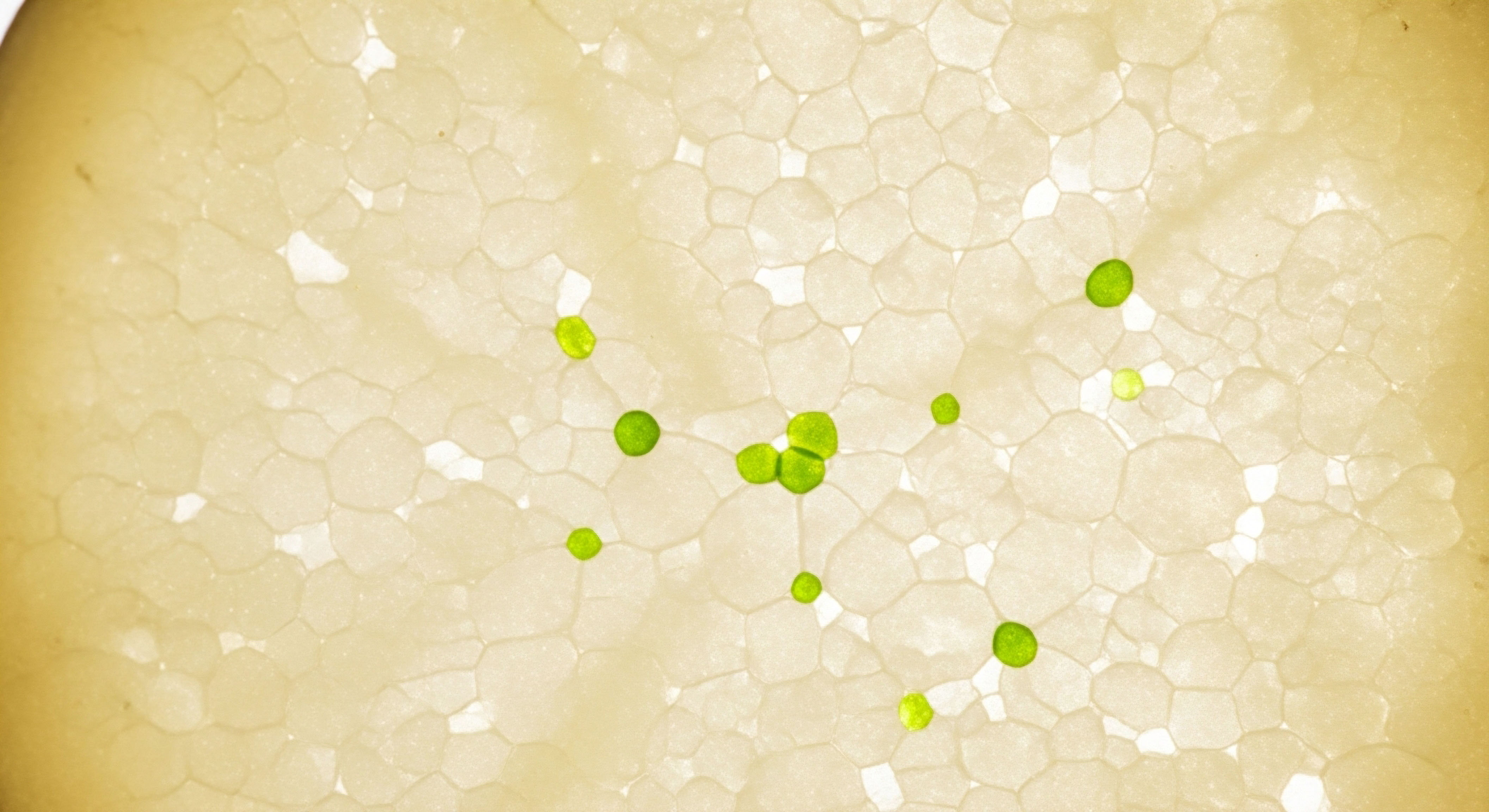

Fundamentals
Do you ever experience those days when your body feels like it is running on empty, even after a night’s rest? Perhaps you push through a demanding workout, only to find lingering soreness and a general sense of depletion that extends beyond simple muscle fatigue.
This feeling, a persistent drag on your vitality, often signals a deeper conversation happening within your biological systems. Your body communicates its needs through symptoms, and understanding these signals marks the initial step toward reclaiming your well-being.
The human body operates as an intricate network of communication pathways, where chemical messengers, known as hormones, orchestrate nearly every physiological process. These messengers direct everything from your energy levels and mood to your ability to recover from physical exertion.
When physical stress becomes a regular part of your life, whether from intense exercise, demanding work, or daily pressures, these internal communication systems can become strained. The body’s response to stress involves a complex interplay of endocrine glands, leading to shifts in hormonal balance that can affect recovery, sleep quality, and overall resilience.
Your body’s persistent fatigue after physical demands often points to an imbalance in its internal communication systems.

The Body’s Stress Response System
When faced with physical demands, your body activates its stress response system, primarily involving the Hypothalamic-Pituitary-Adrenal (HPA) axis. This sophisticated system releases hormones like cortisol, which helps mobilize energy resources to meet the immediate challenge. While essential for acute survival and performance, a prolonged or excessive activation of this system can lead to systemic wear and tear. This can manifest as extended recovery times, persistent inflammation, and a general feeling of being “run down.”
Consider the athlete who trains intensely, or the individual whose daily life involves significant physical strain. Their bodies are constantly adapting, repairing, and rebuilding. This repair process relies heavily on efficient cellular communication and regeneration. When this efficiency wanes, recovery slows, and the body remains in a state of heightened alert, impacting not only physical restoration but also mental clarity and emotional equilibrium.

Introducing Biological Messengers
Within this complex biological landscape, certain molecules serve as highly specific messengers, guiding cellular repair and systemic balance. These are peptides, short chains of amino acids that direct particular biological actions. Unlike larger proteins, peptides are smaller, allowing them to interact with specific receptors and influence cellular processes with precision. Their role in signaling and regulation makes them compelling subjects for supporting the body’s natural restorative capacities.
The concept of supporting recovery from physical stress extends beyond simply resting. It involves actively assisting the body’s inherent mechanisms for repair and regeneration. This includes addressing the inflammatory responses that follow exertion and facilitating the rebuilding of damaged tissues. Understanding how specific biological agents can assist in these processes opens avenues for enhancing vitality and functional capacity.


Intermediate
The journey toward optimal recovery from physical stress involves understanding the precise tools available to support your body’s innate healing abilities. One such tool gaining attention in the realm of regenerative science is Pentadeca Arginate (PDA). This synthetic peptide, a modified version of the naturally occurring Body Protective Compound-157 (BPC-157), holds promise for its role in tissue repair and inflammation modulation.
The addition of an arginate salt aims to enhance its stability and bioavailability, making it a refined agent for targeted biological support.

How Does Pentadeca Arginate Aid Recovery?
Pentadeca Arginate operates through several proposed mechanisms to assist the body in its recovery from physical demands. Its actions are centered on promoting cellular regeneration and mitigating the effects of physical strain.
- Angiogenesis Promotion ∞ PDA may stimulate the formation of new blood vessels, a process known as angiogenesis. Improved blood flow delivers essential oxygen and nutrients to damaged tissues, accelerating their repair and regeneration. This is particularly relevant for areas that experience high metabolic demand during physical activity, such as muscles and tendons.
- Anti-Inflammatory Effects ∞ Physical stress often leads to localized inflammation, a natural but sometimes excessive response that can impede healing. PDA exhibits anti-inflammatory properties, which can help reduce swelling and discomfort. By moderating the inflammatory cascade, the peptide creates a more conducive environment for tissue restoration.
- Collagen Synthesis Enhancement ∞ Collagen provides structural integrity to connective tissues, including tendons, ligaments, and skin. PDA appears to enhance collagen production, contributing to stronger, more resilient tissues. This is vital for rebuilding and reinforcing structures compromised by physical exertion or injury.
- Extracellular Matrix Support ∞ The extracellular matrix provides the scaffolding for cells and tissues. PDA supports the synthesis of proteins within this matrix, further aiding in structural repair and tissue integrity. This comprehensive support for the tissue environment contributes to more robust and lasting recovery.
These actions collectively suggest that PDA can play a supportive role in the body’s response to physical stress, helping to restore tissue integrity and reduce the duration of recovery.
Pentadeca Arginate supports physical recovery by enhancing blood flow, reducing inflammation, and promoting tissue rebuilding.

Integrating Pentadeca Arginate into Wellness Protocols
The application of Pentadeca Arginate can be considered within broader personalized wellness protocols, particularly those focused on hormonal balance and metabolic function. Physical stress, especially chronic or intense exertion, can significantly impact the endocrine system. For instance, sustained high levels of cortisol, a stress hormone, can influence the production of other hormones, including testosterone. This interplay underscores the importance of a comprehensive approach to recovery.
Consider the following table outlining how PDA might complement existing protocols:
| Protocol Type | Impact of Physical Stress | Potential PDA Contribution |
|---|---|---|
| Testosterone Replacement Therapy (TRT) ∞ Men | Intense training can temporarily suppress natural testosterone production; increased cortisol may affect recovery. | Supports tissue repair and reduces inflammation, aiding recovery from training-induced micro-trauma, potentially lessening the catabolic impact of stress hormones. |
| Testosterone Replacement Therapy ∞ Women | Hormonal fluctuations can affect recovery and tissue resilience; physical demands may exacerbate symptoms. | Assists in collagen synthesis for connective tissue health, potentially improving recovery from exercise and supporting overall tissue integrity in the context of hormonal recalibration. |
| Growth Hormone Peptide Therapy | GH peptides aim to enhance recovery, muscle gain, and fat loss; physical stress requires efficient cellular repair. | Complements GH peptide actions by directly promoting angiogenesis and tissue regeneration, potentially accelerating the benefits of GH therapy for physical restoration. |
| Post-TRT or Fertility-Stimulating Protocol (Men) | Body is adjusting hormonal pathways; physical stress could add strain to a system in recalibration. | Offers general tissue support and anti-inflammatory benefits, assisting the body’s recovery processes while it re-establishes endogenous hormone production. |
The goal is to create an environment where the body can efficiently repair and adapt, minimizing the negative feedback loops that prolonged stress can initiate. By supporting tissue integrity and modulating inflammatory responses, PDA contributes to a more resilient physiological state, allowing individuals to maintain activity levels and recover more effectively.

Understanding Hormonal Adaptations to Physical Demands
The body’s endocrine system responds dynamically to physical exertion. During intense activity, the sympathetic nervous system activates, leading to a rapid release of catecholamines like adrenaline and noradrenaline. These hormones prepare the body for action by increasing heart rate, blood pressure, and energy availability. Simultaneously, the HPA axis becomes active, releasing cortisol, which helps mobilize glucose for immediate energy.
Following exertion, the body shifts into a recovery phase, where anabolic hormones play a more prominent role. Hormones such as testosterone, growth hormone (GH), and insulin-like growth factor-1 (IGF-1) are critical for protein synthesis and tissue remodeling. Protocols involving high volume, moderate-to-high intensity, and short rest intervals tend to elicit the greatest acute elevations in these anabolic hormones.
Supporting these natural hormonal responses with targeted interventions, such as peptides that aid tissue repair, can enhance the overall recovery trajectory.


Academic
A deeper examination of Pentadeca Arginate’s influence on recovery from physical stress requires a look into its molecular interactions and systemic effects. While often discussed in relation to BPC-157, PDA distinguishes itself through specific modifications that aim to enhance its therapeutic utility. The core mechanisms revolve around its capacity to modulate cellular signaling pathways involved in tissue homeostasis and regeneration.

Molecular Mechanisms of Pentadeca Arginate Action
Pentadeca Arginate, a synthetic 15-amino acid peptide, is designed to exert its effects at the cellular and subcellular levels. Its primary actions appear to be mediated through pathways that promote vascularization, reduce inflammation, and stimulate extracellular matrix components.
- Vascular Endothelial Growth Factor (VEGF) Pathway Modulation ∞ PDA’s ability to promote angiogenesis is likely linked to its influence on growth factors, particularly those involved in vascular development. By supporting the formation of new capillaries, PDA ensures that damaged tissues receive an adequate supply of oxygen and nutrients, which are indispensable for cellular repair and metabolic waste removal. This enhanced perfusion is a foundational element for accelerating recovery from ischemic or traumatic injuries.
- Nitric Oxide (NO) Production Enhancement ∞ Some research indicates that PDA may enhance nitric oxide production. Nitric oxide is a potent vasodilator and signaling molecule involved in numerous physiological processes, including blood flow regulation, immune response, and cellular communication. Increased NO availability could contribute to improved circulation within injured areas, further supporting healing processes.
- Fibroblast Activity and Collagen Remodeling ∞ Physical stress, especially repetitive strain or acute injury, can lead to micro-tears and structural damage in connective tissues. PDA’s reported ability to increase Type I collagen synthesis and support fibroblast infiltration is highly relevant here. Fibroblasts are the primary cells responsible for producing collagen and other extracellular matrix components. By stimulating their activity, PDA facilitates the organized deposition of new collagen fibers, which is essential for restoring the mechanical strength and integrity of tendons, ligaments, and muscles. This process is critical for long-term tissue health, moving beyond temporary pain management to genuine structural restoration.
- Cytokine and Chemokine Regulation ∞ The inflammatory response following physical stress involves a complex array of cytokines and chemokines. PDA’s anti-inflammatory properties suggest an ability to modulate these signaling molecules, dampening excessive or prolonged inflammation that can hinder recovery. By shifting the inflammatory milieu toward a pro-resolving state, PDA may reduce pain and accelerate the transition from the inflammatory phase to the proliferative and remodeling phases of healing.
These intricate molecular interactions underscore PDA’s potential as a therapeutic agent for supporting recovery from various forms of physical stress, from acute injuries to chronic overexertion.
Pentadeca Arginate influences cellular repair by enhancing blood vessel growth, modulating inflammatory signals, and boosting collagen production.

Interplay with Endocrine and Metabolic Systems
The body’s response to physical stress is not isolated to the musculoskeletal system; it profoundly impacts the endocrine and metabolic networks. Intense or prolonged physical exertion can trigger a cascade of hormonal adjustments, aiming to maintain energy homeostasis and facilitate repair.
The Hypothalamic-Pituitary-Gonadal (HPG) axis, responsible for regulating reproductive hormones, can be influenced by chronic physical stress. For instance, overtraining can lead to a suppression of testosterone in men and menstrual irregularities in women, reflecting the body’s prioritization of immediate survival over reproductive functions. Cortisol, released by the HPA axis in response to stress, can directly antagonize the actions of anabolic hormones like testosterone and growth hormone, potentially hindering recovery and muscle protein synthesis.
The metabolic system also undergoes significant shifts. Intense exercise depletes glycogen stores and increases the demand for glucose, leading to adjustments in insulin sensitivity and glucose uptake. Peptides like PDA, by supporting tissue repair and reducing inflammation, may indirectly alleviate some of the metabolic burden associated with prolonged recovery, allowing the body to return to a state of metabolic equilibrium more efficiently.
Consider the following summary of hormonal and metabolic responses to physical stress and PDA’s potential influence:
| Hormone/System | Response to Physical Stress | Potential PDA Influence on Recovery |
|---|---|---|
| Cortisol (HPA Axis) | Elevated, especially with high intensity/duration; catabolic effects on muscle tissue. | Reduces inflammation and accelerates tissue repair, potentially mitigating the prolonged catabolic effects of elevated cortisol by speeding up healing processes. |
| Testosterone (HPG Axis) | Can be suppressed by chronic stress or overtraining; essential for muscle protein synthesis. | Supports the structural integrity of tissues, which may indirectly assist in maintaining an anabolic environment conducive to testosterone’s actions, even under stress. |
| Growth Hormone (GH) & IGF-1 | Acute elevations post-exercise aid protein synthesis and tissue remodeling. | Directly promotes cellular regeneration and angiogenesis, potentially augmenting the tissue-remodeling effects of GH and IGF-1, leading to more efficient repair. |
| Metabolic Homeostasis | Glycogen depletion, altered insulin sensitivity, increased energy demand. | By accelerating tissue repair and reducing inflammation, PDA may lessen the metabolic strain of prolonged recovery, helping the body restore energy balance. |
The scientific understanding of PDA is still expanding, with much of the current evidence derived from preclinical studies. Further human clinical trials are necessary to fully elucidate its efficacy and optimal application in various physical stress scenarios. However, the existing data suggest a promising role for PDA in supporting the complex biological processes that underpin recovery, offering a targeted approach to enhancing the body’s restorative capabilities.

Can Pentadeca Arginate Offer a New Approach to Recovery?
The traditional view of recovery often centers on rest and basic nutritional support. However, as our understanding of cellular biology and peptide signaling advances, the potential for more targeted interventions becomes clear. Pentadeca Arginate represents a step in this direction, offering a specific molecular tool to address the physiological consequences of physical stress. Its proposed actions on angiogenesis, inflammation, and collagen synthesis directly address key bottlenecks in the recovery process.
This approach moves beyond general support, aiming to actively facilitate the body’s repair mechanisms. For individuals experiencing persistent challenges with recovery, or those seeking to optimize their physical resilience, understanding the potential of agents like PDA opens new avenues for personalized wellness strategies. The integration of such peptides into a comprehensive protocol, alongside hormonal optimization and metabolic support, offers a sophisticated pathway toward reclaiming vitality and functional capacity.

References
- “Comparing Pentadeca Arginate to BPC-157 ∞ A Comprehensive Analysis.” Innovation Health. (Source provides details on PDA’s mechanism, angiogenesis, anti-inflammatory effects, collagen synthesis, and comparison to BPC-157, noting preliminary research).
- “Pentadeca Arginate ∞ Advanced Oral Peptide Therapy for Healing & Recovery.” (Source discusses PDA’s benefits including pain reduction, enhanced collagen synthesis, wound/bone healing, anti-inflammatory effects, and brain-gut axis interactions).
- “Pentadeca Arginate vs BPC-157 ∞ Understanding the Differences.” Amazing Meds. (Source details PDA’s mechanism of action, including nitric oxide production, angiogenesis, and extracellular matrix protein synthesis, and its applications).
- “Pentadecapeptide Arginate Peptide.” Mind Body Neurology®. (Source highlights PDA’s role in tissue repair, inflammation management, collagen production, and benefits for chronic pain/inflammation).
- “Peptide Therapy ∞ BPC-157 & More.” Simply Wellness. (Source explains PDA as a synthetic variation of BPC-157, its enhanced stability, and proposed mechanisms like tissue repair, gut health support, and reduced inflammation).
- “Long-Term Exercise and Hormonal Adaptations Explained.” MASI Anti-Aging Supplements. (Source discusses hormonal exercise response model, catecholamines, and cortisol release).
- “How Does Physical Activity Modulate Hormone Responses?” PMC – PubMed Central. (Source details HPA axis activation, cortisol levels, and the role of catecholamines in response to exercise).
- “Hormonal Adaptations To Resistance Training.” The Sports Edu. (Source explains acute hormonal responses to resistance training, including testosterone, GH, IGF-1, and cortisol).
- “Hormonal responses and adaptations to resistance exercise and training.” PubMed. (Source discusses acute hormonal elevations, their importance for tissue growth, and protocols that elicit greatest elevations).
- “Hormones and Exercise Muscle Adaptations.” Frontiers. (Source highlights the role of testosterone, GH, and IGF-1 in muscle adaptation and the impact of physiological fluctuations).

Reflection
The insights shared here represent a pathway toward a more profound understanding of your body’s capacity for restoration. Recognizing the intricate dance between physical demands and your internal biological systems is the initial step in a personalized health journey. This knowledge is not merely information; it is a lens through which you can view your own experiences, translating symptoms into meaningful signals.
Your path to vitality is unique, shaped by your individual physiology and lived experiences. The information presented on Pentadeca Arginate and its interaction with recovery mechanisms offers a glimpse into the sophisticated tools available in modern wellness. Consider this exploration a starting point, an invitation to engage more deeply with your own biological systems. True well-being arises from a partnership with your body, guided by informed choices and a commitment to understanding its complex needs.

What Does Optimal Recovery Mean for You?
Defining optimal recovery extends beyond the absence of pain; it encompasses a return to full functional capacity, mental clarity, and emotional balance. It is about feeling resilient, capable, and ready to meet life’s demands. This state is not achieved passively; it requires active support for the body’s inherent restorative processes.
As you consider the implications of these biological insights, reflect on your own experiences with physical stress and recovery. What signals is your body sending? How might a deeper understanding of its internal communication systems allow you to better support its needs? The journey toward enhanced well-being is continuous, marked by ongoing learning and personalized application of scientific knowledge.



